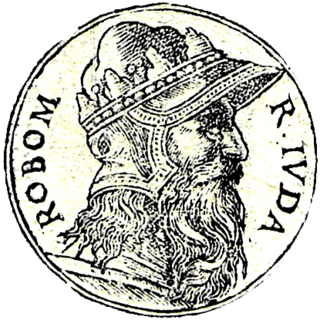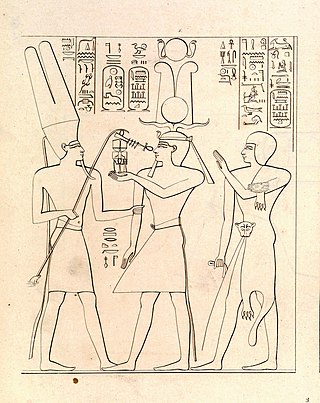
Jeroboam I was, according to the Hebrew Bible, the first king of the northern Kingdom of Israel following a revolt of the ten tribes against Rehoboam that put an end to the United Monarchy.

Rehoboam was, according to the Hebrew Bible, the first monarch of the Kingdom of Judah after the split of the united Kingdom of Israel. He was a son of and the successor to Solomon and a grandson of David. In the account of I Kings and II Chronicles, Rehoboam saw his rule limited to only the Kingdom of Judah in the south following a rebellion by the ten northern tribes of Israel in 932/931 BCE, which led to the formation of the independent Kingdom of Israel under the rule of Jeroboam in the north.
The 9th century BC started the first day of 900 BC and ended the last day of 801 BC. It was a period of great change for several civilizations. In Africa, Carthage is founded by the Phoenicians. In Egypt, a severe flood covers the floor of Luxor temple, and years later, a civil war starts.
The 10th century BC comprises the years from 1000 BC to 901 BC. This period followed the Late Bronze Age collapse in the Near East, and the century saw the Early Iron Age take hold there. The Greek Dark Ages which had come about in 1200 BC continued. The Neo-Assyrian Empire is established towards the end of the 10th century BC. In the Iron Age in India, the Vedic period is ongoing. In China, the Zhou dynasty is in power. Bronze Age Europe continued with Urnfield culture. Japan was inhabited by an evolving hunter-gatherer society during the Jōmon period.
This article concerns the period 799 BC – 790 BC.
The 910s BC is a decade which lasted from 919 BC to 910 BC.

Hedjkheperre Setepenre Shoshenq I —also known as Shashank or Sheshonk or Sheshonq I—was a pharaoh of ancient Egypt and the founder of the Twenty-second Dynasty of Egypt. Of Meshwesh ancestry, Shoshenq I was the son of Nimlot A, Great Chief of the Ma, and his wife Tentshepeh A, a daughter of a Great Chief of the Ma herself; Shoshenq was thus the nephew of Osorkon the Elder, a Meshwesh king of the 21st Dynasty. He is generally presumed to be the Shishak mentioned in the Hebrew Bible, and his exploits are carved on the Bubastite Portal at Karnak.
Shishak, also spelled Shishaq or Susac, was, according to the Hebrew Bible, an Egyptian pharaoh who sacked Jerusalem in the 10th century BCE. He is usually identified with the pharaoh Shoshenq I.
Kenneth Anderson Kitchen is a British biblical scholar, Ancient Near Eastern historian, and Personal and Brunner Professor Emeritus of Egyptology and honorary research fellow at the School of Archaeology, Classics and Egyptology, University of Liverpool, England. He specialises in the ancient Egyptian Ramesside Period, and the Third Intermediate Period of Egypt, as well as ancient Egyptian chronology, having written over 250 books and journal articles on these and other subjects since the mid-1950s. He has been described by The Times as "the very architect of Egyptian chronology".

Matthew 1:7 is the seventh verse of the first chapter of the Gospel of Matthew in the New Testament. The verse is part of the section where the genealogy of Joseph, the legal father of Jesus, is listed.

Sekhemkheperre Osorkon I was an ancient Egyptian pharaoh of the 22nd Dynasty. Osorkon's territory included much of the Levant.
The Sukkites were an ancient African nation. It is mentioned in the Hebrew Bible as one of three that participated with King Shishaq of Egypt when he attacked Jerusalem. This is the only biblical reference to Sukkiim.

The High Priest of Amun or First Prophet of Amun was the highest-ranking priest in the priesthood of the ancient Egyptian god Amun. The first high priests of Amun appear in the New Kingdom of Egypt, at the beginning of the Eighteenth Dynasty.

The Bible makes reference to various pharaohs of Egypt. These include unnamed pharaohs in events described in the Torah, as well as several later named pharaohs, some of whom were historical or can be identified with historical pharaohs.

The great Battle of Mount Zemaraim was reported in the Bible to have been fought in Mount Zemaraim, when the army of the Kingdom of Israel led by the king Jeroboam I encountered the army of the Kingdom of Judah led by the king Abijah I. About 500,000 Israelites were said to have lain dead after this single engagement, though most modern commentators consider the numbers to be either wildly exaggerated or symbolic, and some have even questioned its fundamental historicity. A chronology proposed by Edwin Thiele suggests the battle would have taken place around 913 BC.

According to the First Book of Kings and the Second Book of Chronicles of the Hebrew Bible, Jeroboam's Revolt was an armed insurrection against Rehoboam, king of the United Monarchy of Israel, and subsequently the Kingdom of Judah, led by Jeroboam in the late 10th century BCE. The conflict, referring to the independence of the Kingdom of Samaria and the subsequent civil war during Jeroboam's rule, is said to have begun shortly after the death of Solomon lasting until the Battle of Mount Zemaraim. The conflict began due to discontent under the rule of Solomon's successor, his son Rehoboam, and was waged with the goal of breaking away from the United Monarchy of Israel. Though this goal was achieved very early on in the conflict, the war continued throughout the duration of Rehoboam's reign and well into the reign of his son, Abijam, who defeated the armies of Jeroboam but failed to reunite the kingdoms.

2 Chronicles 12 is the twelfth chapter of the Second Book of Chronicles the Old Testament in the Christian Bible or of the second part of the Books of Chronicles in the Hebrew Bible. The book is compiled from older sources by an unknown person or group, designated by modern scholars as "the Chronicler", and had the final shape established in late fifth or fourth century BCE. This chapter belongs to the section focusing on the kingdom of Judah until its destruction by the Babylonians under Nebuchadnezzar and the beginning of restoration under Cyrus the Great of Persia. The focus of this chapter is the kingdom of Israel's division in the beginning of Rehoboam's reign.

1 Kings 14 is the fourteenth chapter of the Books of Kings in the Hebrew Bible or the First Book of Kings in the Old Testament of the Christian Bible. The book is a compilation of various annals recording the acts of the kings of Israel and Judah by a Deuteronomic compiler in the seventh century BCE, with a supplement added in the sixth century BCE. 1 Kings 12:1 to 16:14 documents the consolidation of the kingdoms of northern Israel and Judah: this chapter focusses on the reigns of Jeroboam and Nadab in the northern kingdom and Rehoboam in the southern kingdom.